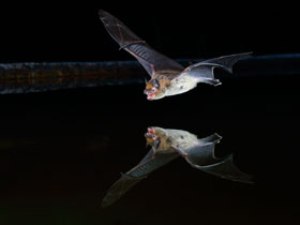Feb 9 2016
Climate change is most likely behind the extraordinary spread of a type of vesper bat across Europe over the last four decades. Kuhl's pipistrelle has extended its range by nearly 400 percent, says Leonardo Ancillotto, lead author of a study supervised by Danilo Russo of the University of Naples Federico II in Italy, in Springer’s journal The Science of Nature. It is the first to record a range expansion for bats on such a continental scale.

Pipistrelles are very adaptable bats, and can roost and thrive in a variety of landscapes, including urban areas. These characteristics made the Kuhl's pipistrelle (Pipistrellus kuhlii) a good species to study, as part of efforts by Russo’s research team to understand what drives the ongoing distribution and movement of animals across different regions.
The team collected 25,132 high-resolution records of where the bat occurred in Europe between 1980 and 2013. These were used in conjunction with various models to predict whether the colonisation of new areas over the years has been prompted by increased urbanisation or by changes in the climate.
When first recorded, Kuhl's pipistrelle was typically found over large areas of North Africa, southern Europe and Western Asia. In southern Europe its distribution was originally confined to the Mediterranean basin. It extended east to the Balkans, west to the Iberian Peninsula and north to the Alps and western France. By the 1980s, the bat was also reported in northern France and Bulgaria. Slowly but surely it has spread to other countries, including the United Kingdom to the north and eastern regions such as the Czech Republic, Slovakia, Ukraine, Hungary, Romania, Bulgaria, Serbia and Poland.
Kuhl's pipistrelle has therefore largely expanded its geographical range in the last forty years. The models indicate that this has happened in response to climate change, and in particular because of warmer winter temperatures experienced in the newly colonised regions at higher latitudes. The warmer an area has become, the more likely it is that the bat will have spread there. This pattern is also influenced to a lesser degree by a region’s average annual rainfall and the particular rainfall season. These factors influence the availability of water and insects as a food source.
Although urbanisation increased in many recently colonised areas, it had little effect on the species' presence predictability. The increase in artificial light because of increased urbanisation did not have much influence on the bat’s range expansion, despite the fact that the bat is commonly found in urban areas.
“According to our work, the Kuhl's pipistrelle is a ‘winner’ in the context of climate change,” says lead author Ancillotto. “Given its high ecological flexibility, it might be strong competition to other bats in the regions that it newly occupies, and have serious consequences on bat assemblages.”
Reference: Ancillotto, L., Santini, L., Ranc, N., Maiorano, L., Russo, D. (2016). Extraordinary range expansion in a common bat: the potential roles of climate change and urbanisation, The Science of Nature, DOI 10.1007/s00114-016-1334-7